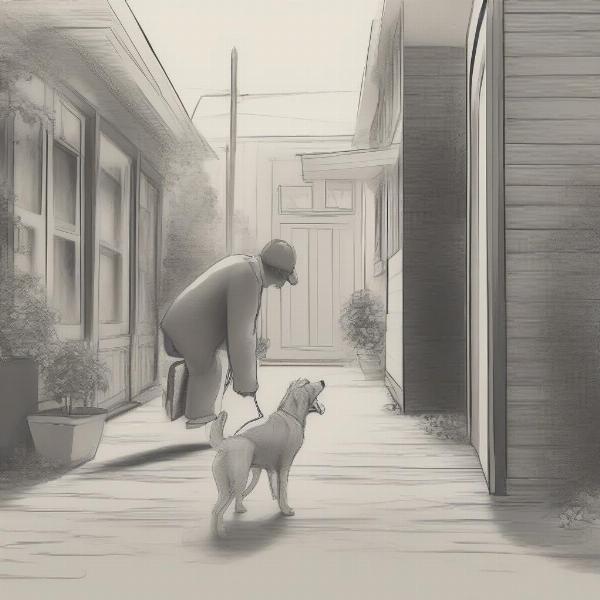Adopting a rescue dog is a rewarding experience, but it often comes with unique challenges, one of which is potty training. Unlike puppies who are on a predictable learning curve, rescue dogs come with unknown histories and potential baggage. This guide will equip you with the necessary tools and knowledge to successfully potty train your new furry friend.
Understanding Your Rescue Dog’s Background
Before diving into potty training, take time to understand your rescue dog’s past. Were they housed in a shelter, a foster home, or perhaps even lived on the streets? Their prior living situation significantly impacts their current habits. A dog accustomed to eliminating indoors might require more patience and understanding. Similarly, a dog with past trauma may exhibit anxiety related to going outside.
Establishing a Routine
Consistency is key to successful potty training. Establish a regular feeding schedule, as this directly influences bowel movements. Take your dog outside immediately after waking up, after meals, after naps, and before bedtime. Choose a specific potty spot in your yard and consistently take them there.
Recognizing the Signs
Learn to recognize your dog’s subtle cues that signal the need to eliminate. These can include restlessness, pacing, whining, circling, sniffing the ground intensely, or squatting. As soon as you notice these signs, promptly take your dog outside to their designated potty spot.  Dog exhibiting signs of needing to potty
Dog exhibiting signs of needing to potty
Positive Reinforcement
Positive reinforcement is crucial. When your dog successfully eliminates outdoors, reward them immediately with praise, a small treat, or a favorite toy. Keep the reward system consistent to solidify the connection between outdoor elimination and positive outcomes. Avoid punishment for accidents, as this can create fear and anxiety, making the process more challenging.
Dealing with Accidents
Accidents are bound to happen, especially in the early stages. If you catch your dog in the act, interrupt them with a firm “No” and immediately take them outside to their designated spot. If you discover an accident after the fact, simply clean it up thoroughly with an enzymatic cleaner to eliminate the odor and discourage repeat offenses. Do not scold or punish your dog, as they will not understand the connection to the past action.
Crate Training: A Helpful Tool
Crate training can be an effective tool in potty training, as dogs instinctively avoid soiling their den. Introduce the crate gradually and make it a positive experience with toys and treats. Never use the crate as punishment. Ensure the crate is appropriately sized – large enough for your dog to stand, turn around, and lie down comfortably, but not so large that they can eliminate in one corner and sleep in another.
When to Seek Professional Help
If you’re struggling with potty training your rescue dog, don’t hesitate to seek professional guidance from a certified dog trainer or veterinarian behaviorist. They can assess your dog’s specific needs and develop a tailored training plan.
Conclusion
Potty training a rescue dog requires patience, consistency, and understanding. By following these guidelines and focusing on positive reinforcement, you can help your new companion adjust to their new home and establish healthy potty habits. Remember, every dog is different, and the process may take time. Celebrate the small victories and enjoy the journey of building a strong bond with your rescued friend.
FAQ
- How long does it usually take to potty train a rescue dog? It varies depending on the dog’s age, history, and your consistency, but it can take anywhere from a few weeks to several months.
- What should I do if my rescue dog is afraid to go outside? Start with short trips outside and gradually increase the duration. Use positive reinforcement and make the experience enjoyable.
- Is it okay to use puppy pads for a rescue dog? While they can be a temporary solution, they can also prolong the potty training process. It’s best to focus on outdoor elimination from the beginning.
- My rescue dog keeps having accidents in the same spot. What should I do? Clean the area thoroughly with an enzymatic cleaner to eliminate the odor that might be attracting them back.
- Should I take my rescue dog out on a leash for potty breaks? Yes, this helps you maintain control and focus their attention on eliminating.
- My rescue dog seems to regress in their potty training. What could be the cause? Changes in routine, stress, or medical conditions can sometimes cause regression. Consult with your veterinarian.
- What if my rescue dog refuses treats during potty training? Try different types of high-value rewards like small pieces of cooked chicken or a favorite toy.
ILM Dog is your premier resource for expert advice on all aspects of dog care, from breed selection and health to training, nutrition, grooming, and much more. We offer a wealth of practical and reliable information to help you provide the best possible care for your canine companion. Whether you’re a new dog owner or a seasoned pro, ILM Dog has something for you. Contact us today at [email protected] or +44 20-3965-8624 to learn more about our services.